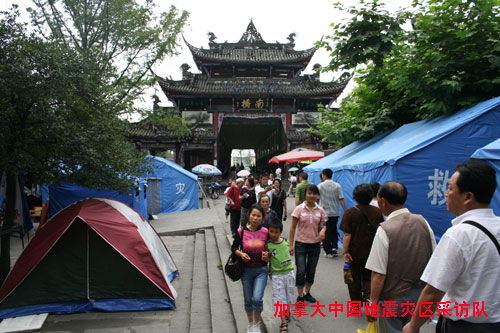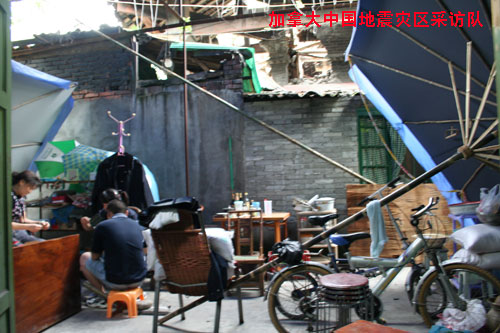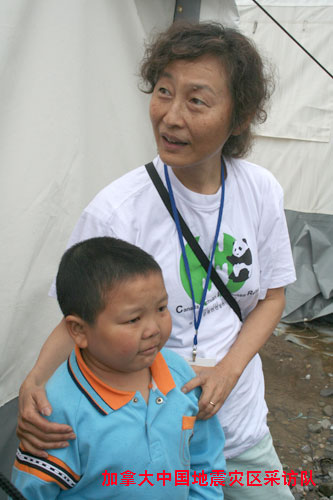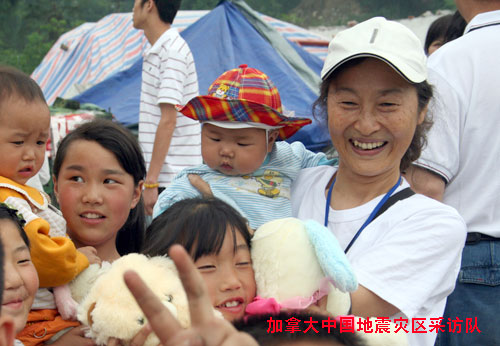第五天-都江堰市 周一 2008-06-16
(加拿大中国地震灾区采访队记者Christina Stevens6月15日报道)
“快呀,快呀”
54岁的杨小齐心急的向前走,渴望带我们去看一看都江堰市。她很兴奋但也很紧张,因不知会看到些什么。我们走向河边,沿着河畔小径往前走。这里昔日是风景优美的河滨,但如今已变成民众的临时居所。我们穿插于他们的饭桌、睡床及电视机等杂物之间。在这堆帐篷之中,电视机是给人们一点儿快乐的重要东西。帐篷间原是居民的房屋,这时古老大梁交错重叠,大厅外露,墙壁剥落。
杨小齐带着我们在迷阵中穿越,人们望着我们都会打招呼,甚至有居民会到厨房看看有什么食物可供招呼。他们其实没甚食物,但还是要招呼我们。他们都是都江堰的居民,可惜我没有时间与他们谈话,因为杨小奇瘦小的身躯迅间便转到另一角落。她是多伦多来的,不过她家族在四川有长远历市,因此她很焦急要看一看一座大桥,是否能够抵受地震的破坏。
从远处看像是一座伟大庙宇似的,但走近了才发现原来是南桥的上盖。这建筑物依然屹立不倒,上盖下的木桥行人穿梭来往。我可以想像这大桥一定有上千年的历史,但对于杨小齐来说,这桥的历史远比不上与她家族的关系。她说:“中间两个大字是我父亲写的。”她指着桥顶牌匾两个金色大字。她父亲是这类一位高层官员,亦是一位艺术家,他去年辞世,享年96岁。杨小齐看着牌匾,眼泪夺眶而出。“它还在,所以我很感动。”
这数天来杨小齐要承受很多的东西。她是多伦多四川地震赈灾委员会的人,这组织筹集了五十多万元,赈济这里的灾民。她可以亲眼见到这些善款都用在购买清洁食水给灾民。她说:“人们都有干净食水,这对我来说相当重要。”她很高兴多伦多的人都乐意伸出援手,同时亦为这个市的民众感到骄傲。“这里的人都能活着,而且都设法重回正常生活,我可以说他们都在努力自力更生。”说话时杨小奇有感而发,稍作停顿后便又收拾心情,重新盘算着可以再把我们带到那里。
DAY 5 — DU JIANG YAN MONDAY
(加拿大中国地震灾区采访队记者Christina Stevens6月16日报道)
“Hurry up, hurry up.”
54 year old Sherry Yang bounds ahead, eager to to show us the city of Du Jiang Yan. She is excited but also nervous about what she’ll find. We head for the river and up what used to be a scenic waterside pathway. Instead we find ourselves walking through the middle of people’s makeshift homes. We weave our way around the tables, beds and even the odd TV that make these tarps and tents a fraction more comfortable. Between the tents we come upon what had been these people’s houses. Ancient beams criss cross laneways, and living rooms lay exposed, walls appearing as though they have been peeled back.
Yang confidently leads us through the maze and people greet us good naturedly as we pass through their lives. Some, even looking up from the kitchen table to offer us a bite. They have nothing, and they are offering me their food. These are the people of Du Jiang Yan. I have no time to ponder this as Yang’s lean frame disappears around another corner. Although she is from Toronto her family has a long history here and she is anxious to see if one particular bridge has survived the quake.
From a distance I see what appears to be a magnificent temple, but soon realize it is the imposing roof of the South Bridge. The structure still stands, its wooden planks busy with pedestrians, much as I imagine it would have been when it was built a thousand years ago. But its much more than history that connects Yang to it. “In the middle, the two words were written by my father,” she explains, pointing to two large gold coloured Chinese characters on the roof of the bridge. Her father was an important official here, as well as a talented artist. He died last year at the age of 96. Yang looks again at the painting, stops and dissolves in tears, “It’s still there, that’s why I feel so emotional”.
Over the past few days, Yang has had a lot to absorb. She is a member of the “Sichuan Earthquake Relief Committee”. A Toronto based group which managed to raise half a million dollars for the quake ravaged area. She has had a chance to see exactly how the money is being spent, most of it on clean water. “People get fresh water for drinking and its very important to me that they get that” she explains. She says is proud of Toronto’s efforts to help, and is also proud of this city, “The people here, they are still living, they are still trying to live normally. We can tell they try to help themselves.” She pauses for another moment to collect herself, takes a deep breath, then bounds forward again, eager to show us more.

South Bridge with tent homes, in Du Jiang Yan.

Home in Di Jiang Yan.

Sherry Yang with boy at Red Cross water station.

Sherry Yang with children living in tent village.




